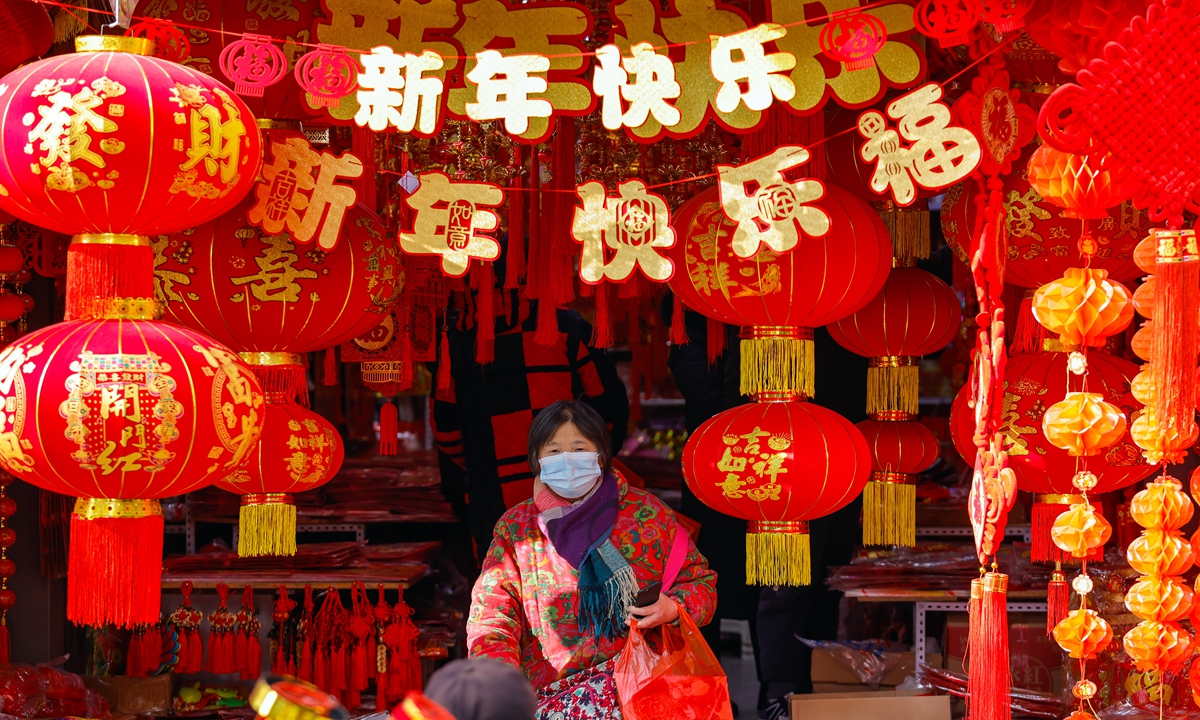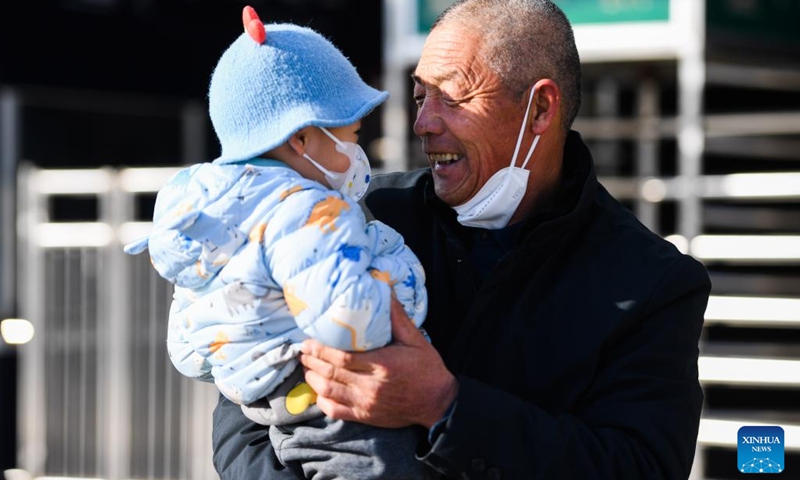
People buy festival items at a wholesale market in Chengdu, Sichuan Province on January 19, 2023 to welcome the upcoming Chinese Lunar New Year.Photo: Xinhua News Agency
The Spring Festival of 2023 is destined to be unique, as it will be a year of return, of remembrance and letting go, of a new start to a more vibrant future after the country has optimized its COVID-19 responses, gradually walking out of the cloud of the epidemic.
After COVID-19 disrupted the plan of many for family reunions during Spring Festival, the most important festival for the Chinese people over the last three years, the pent-up joy of returning home can be felt among millions of luggage-carrying passengers at airports and train stations eager to see their families, along with the return of the hustle and bustle of the Chinese Lunar New Year, or Spring Festival. Solidarity and hard work helped the country weather three years of arduous struggle against COVID-19, allowing it to let go of the fear and uncertainty that came with the coronavirus. As China’s most important festival approaches, the country is roaring back to a more vigorous, shining future, and it is ready to leave the last three bumpy years behind.
Although the risk of COVID-19 still lingers, the massive travel rush has avoided the “darkest moment” of China’s COVID-19 outbreak, with infections and severe cases already peaking nationwide. After shaking off stricter COVID-19 controls as the country has downgraded COVID-19 management from Class A to Class B, its economy is widely expected to take off, initially as a result of unleashed consumption vitality. Economists predicted that with Spring Festival bringing in strong momentum in economic activity, the rebound of China’s economy should come before the second quarter of 2023.
A 34-year-old woman surnamed Chen from Central China’s Hubei Province – where COVID-19 cases were first reported three years ago – still remembered the day when Wuhan imposed the citywide lockdown to cut off the coronavirus transmission, which coincided with the Chinese Lunar New Year of 2020.
“I was told to return to Beijing [where she lives] as the epidemic situation was getting severe. I saw many people like us leaving the province on the day that was supposed to be a time for family reunion,” she said.
At local airports, she witnessed loved ones who had to suddenly separate due to the outbreak and elderly people who had to say goodbye to their children again after a year of separation, all of which became part of the country’s collective memory of the arduous fight against COVID.
Three years later, China accumulated experiences and continuously optimized its epidemic response. With the arrival of chunyun, known as the Spring Festival travel rush, many young people from Hubei who work outside the province like Chen are now preparing to go home. “We deserve a true, happy reunion this Spring Festival,” she said.
Mindy Li, a Chongqing resident who works in Shanghai, used to be anxious about returning to her hometown in Chengdu for Spring Festival. As a single woman in her 30s, she had been pestered by relatives about her relationship status. But this year, she went back home earlier. “After three years’ absence, Spring Festival carries more weight for me. My parents are ageing in front of my eyes. I want to spend as much time with them as possible.”
However, not everyone will be able to enjoy the happiness of reunion with family. A doctor surnamed Chen in a county in Chongqing will be working throughout the holiday. “I haven’t been home for Spring Festival for three years. This will be my fourth year.”
Chen said as the COVID-19 caseload continues to surge in her county, the hospital asked doctors to stay in their posts during the holiday. Chen said her hospital is now receiving five times more fever patients than in previous years.
“Sometimes we work more than 10 hours a day without rest. The patients are mostly old people,” Chen said. She said she wanted to travel with her 3-year-old son during Spring Festival, but “I have no time, and it will be risky as I work in a hospital. So I will just hang in there for a while.”
President Xi Jinping on Wednesday extended festive greetings to all Chinese people when he held virtual talks in the Great Hall of the People in Beijing with people from across the country ahead of Spring Festival.
Speaking with medical workers and an elderly patient at the First Affiliated Hospital of Harbin Medical University in Northeast China’s Heilongjiang Province, Xi said that facing this latest wave of COVID-19 infections, medical workers have worked long hours under heavy pressure and have come under an excessive workload in treating patients.
“We have now entered a new phase of COVID-19 response. Tough challenges remain, but the light of hope is right in front of us. Perseverance means victory,” he said.

A man holds his grandson in arms after going out of Hohhot East Railway Station in Hohhot, north China’s Inner Mongolia Autonomous Region, Jan. 15, 2023. China’s Spring Festival travel rush kicked off on Jan. 7 this year and Chinese people are on their way to have a reunion with their loved ones.(Photo: Xinhua)
A safe holiday
According to official data, as of Wednesday, a total of 480 million trips have been made since the Spring Travel rush started on January 7, an increase of 47.1 percent compared with that of 2020, but still 47.3 percent down compared with the pre-pandemic level in 2019. It is estimated that a total of 2.1 billion trips will be made during the 40-day 2023 Spring Festival travel rush in China.
Many foreign media outlets have hyped that the massive travel rush will contribute to another wave of COVID-19 cases and lead to an increase in the official death toll.
An official from China’s National Health Commission said at a Thursday conference that the number of patients in fever clinics, emergency rooms and with severe symptoms has already peaked. Nationwide, the number of severe COVID-19 cases in hospitals reached tapering point on January 5. The number of these patients decreased 44.3 percent on January 17, compared with the peak number.
Zeng Guang, former chief epidemiologist of the Chinese Center for Disease Control and Prevention (CDC) told the Global Times that “chunyun has avoided the darkest moment of China’s COVID-19 outbreak, as it coincided with the time when COVID-19 caseloads in major cities have already reached tapering point after China optimized its COVID-19 response earlier last month.
As for the second wave, Zeng said that international data indicates that only 10 percent of the population who have been re-infected can be counted as a second wave, and that the data shows new variants have not yet resulted in a second wave in China.
Mi Feng, spokesperson for the National Health Commission, said at the Thursday conference that rural areas are the top priority for current anti-epidemic work in China, and called for proper arrangements to be made for medical resources and services for key groups such as the elderly and children in these areas during the Spring Festival holidays.
Zeng said that the rural areas witnessed the infection peak at the same time as big cities, but it is lingering for longer in rural areas as facilities there are relatively inferior and medicines may not be sufficient, while the influx of arrivals during Spring Festival will almost certainly exacerbate the situation.
He called for less developed places to build better connections with hospitals in big cities so that they can send their patients to better equipped hospitals for treatment in time. He also said that “as the infection wave in big cities is already ebbing away, doctors in big hospitals can help rural areas in person or via online treatment.”
Strong bounce back
As the country has entered a new phase of COVID-19 response, despite tough challenges still remain, the Chinese economy is widely expected to roar back to a fast growth trajectory.
The first Spring Festival after China optimized its COVID-19 response will usher in a good start for consumption to drive the national economy, said Bai Ming, deputy director of the international market research institute at the Chinese Academy of International Trade and Economic Cooperation.
Data from Cainiao, Alibaba’s logistics branch, suggests that the orders it processes during Spring Festival is expected to grow 30 percent compared with the usual figure, and will consist mainly of liquor and gifts for Chinese New Year.
A report from major Chinese travel agency Ctrip shows that as of January 5, travel-hungry Chinese also are expected to spend 53 percent more on travel this Spring Festival, while bookings for tourism-related services have soared 45 percent compared with last year.
“Many predicted that the Chinese economy will only rebound in the second quarter of 2023, while I believe this recovery may come sooner because of the high rate of consumption. When household consumption takes off, it will warm up the overall economic atmosphere,” Tian Yun, former vice director of the Beijing Economic Operation Association, told the Global Times.
Harry Lau, an imported wine merchant from Guangzhou, said he will only take one day off during Spring Festival. The COVID-19 pandemic over the past three years dealt a heavy blow to Lau’s business, with orders halving last year. “This year, I am super busy, because families are reunited, people are going out again, and my orders are expected to return to pre-pandemic levels.”
Looking back at the “tough” last three years, Lau said he feels lucky that he was able to persevere. “Hardship is the last thing we Chinese are afraid of. We’ve endured many tough challenges and have become stronger,” Lau said.
Eager to end the interview, Lau said he “has no time to waste, as I want to make up for the previous sluggish years as soon as possible.”
GT




COMMENTS